Some 100 km away from Beijing, the Xiong’an New Area has been designed as a major recipient of functions transferred from Beijing that are not essential to its role as China’s capital.
The country has also vowed to build Xiong’an, dubbed the “city of the future,” into an innovative, green, smart and world-class city with blue skies, fresh air and clean water, in line with the country’s high-quality development path.
In less than seven years, Xiong’an has been transformed from a blueprint into reality, with over 3,000 buildings rising from the previously barren lowlands and shabby villages. Furthermore, the centrally-administered state-owned enterprises have set up more than 200 subsidiaries and various branches in the area. (Xinhua/Mu Yu)
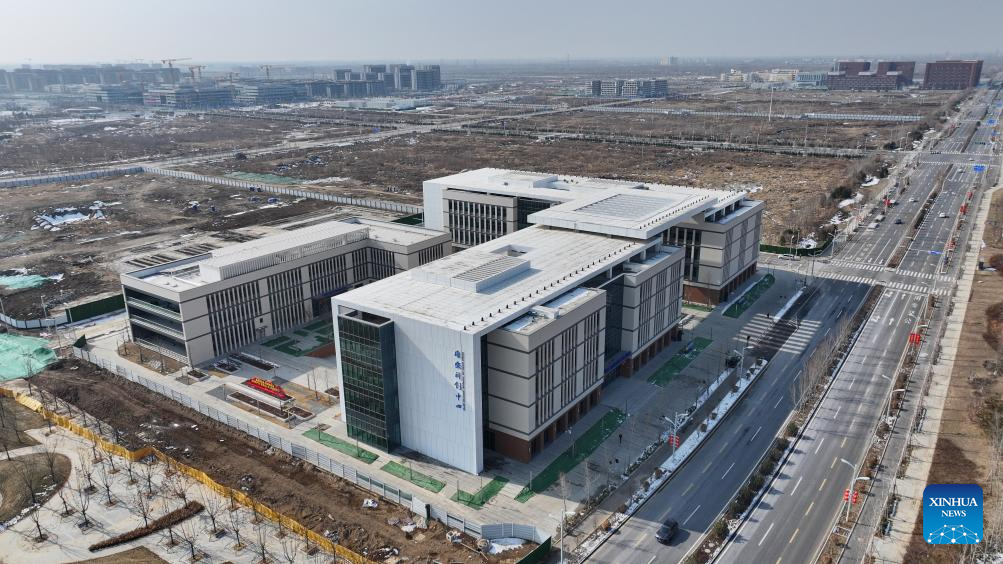
An aerial drone photo taken on Feb. 7, 2024 shows the Xiong’an Science and Technology Innovation Center in Xiong’an New Area, north China’s Hebei Province.
Some 100 km away from Beijing, the Xiong’an New Area has been designed as a major recipient of functions transferred from Beijing that are not essential to its role as China’s capital.
The country has also vowed to build Xiong’an, dubbed the “city of the future,” into an innovative, green, smart and world-class city with blue skies, fresh air and clean water, in line with the country’s high-quality development path.
In less than seven years, Xiong’an has been transformed from a blueprint into reality, with over 3,000 buildings rising from the previously barren lowlands and shabby villages. Furthermore, the centrally-administered state-owned enterprises have set up more than 200 subsidiaries and various branches in the area. (Xinhua/Mu Yu)
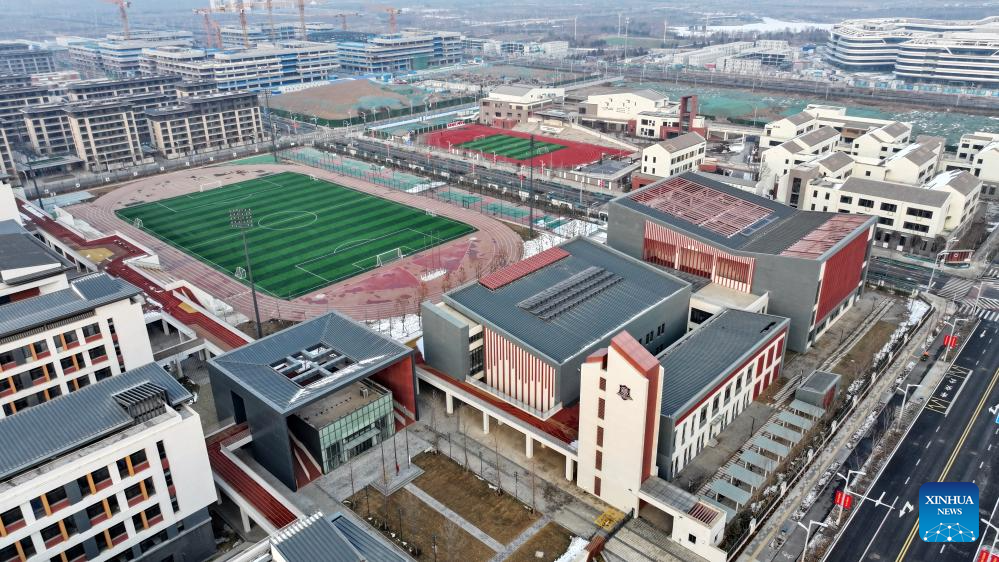
An aerial drone photo taken on Feb. 6, 2024 shows a branch of Beijing No. 4 High School and a branch of Beijing Shijia Primary School in Xiong’an New Area, north China’s Hebei Province.
Some 100 km away from Beijing, the Xiong’an New Area has been designed as a major recipient of functions transferred from Beijing that are not essential to its role as China’s capital.
The country has also vowed to build Xiong’an, dubbed the “city of the future,” into an innovative, green, smart and world-class city with blue skies, fresh air and clean water, in line with the country’s high-quality development path.
In less than seven years, Xiong’an has been transformed from a blueprint into reality, with over 3,000 buildings rising from the previously barren lowlands and shabby villages. Furthermore, the centrally-administered state-owned enterprises have set up more than 200 subsidiaries and various branches in the area. (Xinhua/Mu Yu)
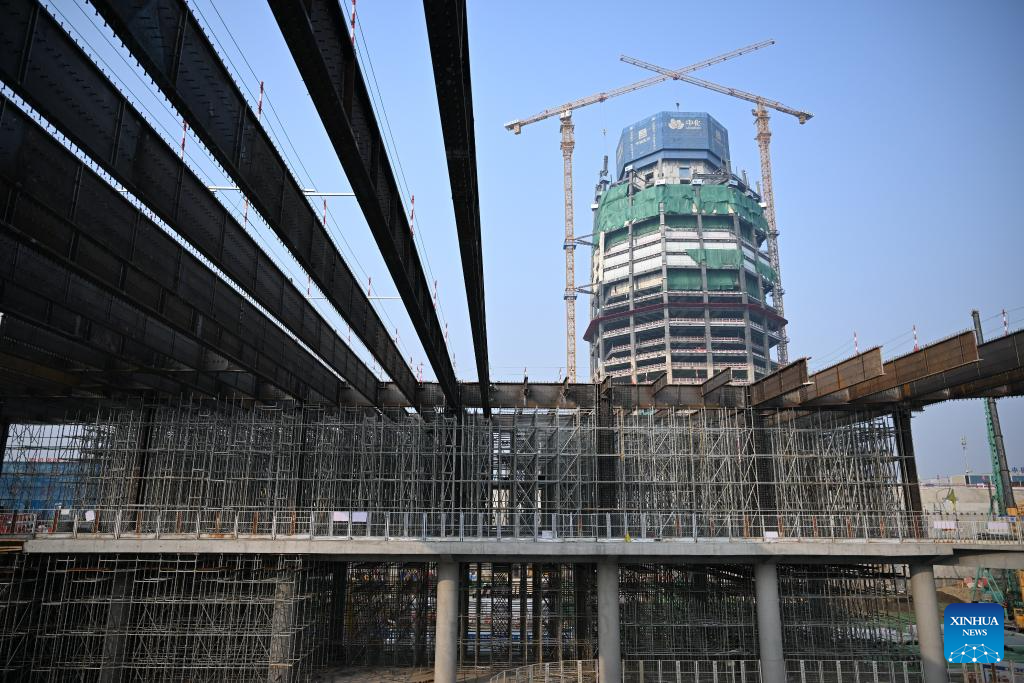
This photo taken on Feb. 6, 2024 shows the construction site of an inter-city railway station and an international trade center in Xiong’an New Area, north China’s Hebei Province.
Some 100 km away from Beijing, the Xiong’an New Area has been designed as a major recipient of functions transferred from Beijing that are not essential to its role as China’s capital.
The country has also vowed to build Xiong’an, dubbed the “city of the future,” into an innovative, green, smart and world-class city with blue skies, fresh air and clean water, in line with the country’s high-quality development path.
In less than seven years, Xiong’an has been transformed from a blueprint into reality, with over 3,000 buildings rising from the previously barren lowlands and shabby villages. Furthermore, the centrally-administered state-owned enterprises have set up more than 200 subsidiaries and various branches in the area. (Xinhua/Mu Yu)
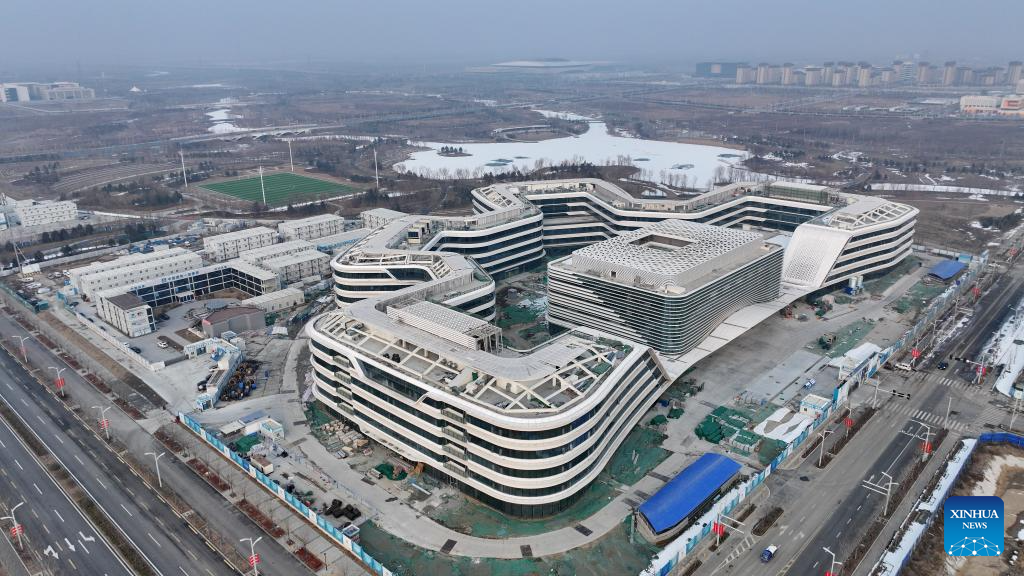
An aerial drone photo taken on Feb. 6, 2024 shows the construction site of the headquarters of China Satellite Network Group in Xiong’an New Area, north China’s Hebei Province.
Some 100 km away from Beijing, the Xiong’an New Area has been designed as a major recipient of functions transferred from Beijing that are not essential to its role as China’s capital.
The country has also vowed to build Xiong’an, dubbed the “city of the future,” into an innovative, green, smart and world-class city with blue skies, fresh air and clean water, in line with the country’s high-quality development path.
In less than seven years, Xiong’an has been transformed from a blueprint into reality, with over 3,000 buildings rising from the previously barren lowlands and shabby villages. Furthermore, the centrally-administered state-owned enterprises have set up more than 200 subsidiaries and various branches in the area. (Xinhua/Mu Yu)

A worker welds steel at the construction site of an inter-city railway station and an international trade center in Xiong’an New Area, north China’s Hebei Province, Feb. 6, 2024.
Some 100 km away from Beijing, the Xiong’an New Area has been designed as a major recipient of functions transferred from Beijing that are not essential to its role as China’s capital.
The country has also vowed to build Xiong’an, dubbed the “city of the future,” into an innovative, green, smart and world-class city with blue skies, fresh air and clean water, in line with the country’s high-quality development path.
In less than seven years, Xiong’an has been transformed from a blueprint into reality, with over 3,000 buildings rising from the previously barren lowlands and shabby villages. Furthermore, the centrally-administered state-owned enterprises have set up more than 200 subsidiaries and various branches in the area. (Xinhua/Mu Yu)

An aerial drone photo taken on Feb. 7, 2024 shows the construction site of the Xiong’an section of the Xiong’an-Xinzhou High-speed Railway in Xiong’an New Area, north China’s Hebei Province.
Some 100 km away from Beijing, the Xiong’an New Area has been designed as a major recipient of functions transferred from Beijing that are not essential to its role as China’s capital.
The country has also vowed to build Xiong’an, dubbed the “city of the future,” into an innovative, green, smart and world-class city with blue skies, fresh air and clean water, in line with the country’s high-quality development path.
In less than seven years, Xiong’an has been transformed from a blueprint into reality, with over 3,000 buildings rising from the previously barren lowlands and shabby villages. Furthermore, the centrally-administered state-owned enterprises have set up more than 200 subsidiaries and various branches in the area. (Xinhua/Mu Yu)

An aerial drone photo taken on Feb. 7, 2024 shows the construction site of Sinochem Holdings buildings in Xiong’an New Area, north China’s Hebei Province.
Some 100 km away from Beijing, the Xiong’an New Area has been designed as a major recipient of functions transferred from Beijing that are not essential to its role as China’s capital.
The country has also vowed to build Xiong’an, dubbed the “city of the future,” into an innovative, green, smart and world-class city with blue skies, fresh air and clean water, in line with the country’s high-quality development path.
In less than seven years, Xiong’an has been transformed from a blueprint into reality, with over 3,000 buildings rising from the previously barren lowlands and shabby villages. Furthermore, the centrally-administered state-owned enterprises have set up more than 200 subsidiaries and various branches in the area. (Xinhua/Mu Yu)
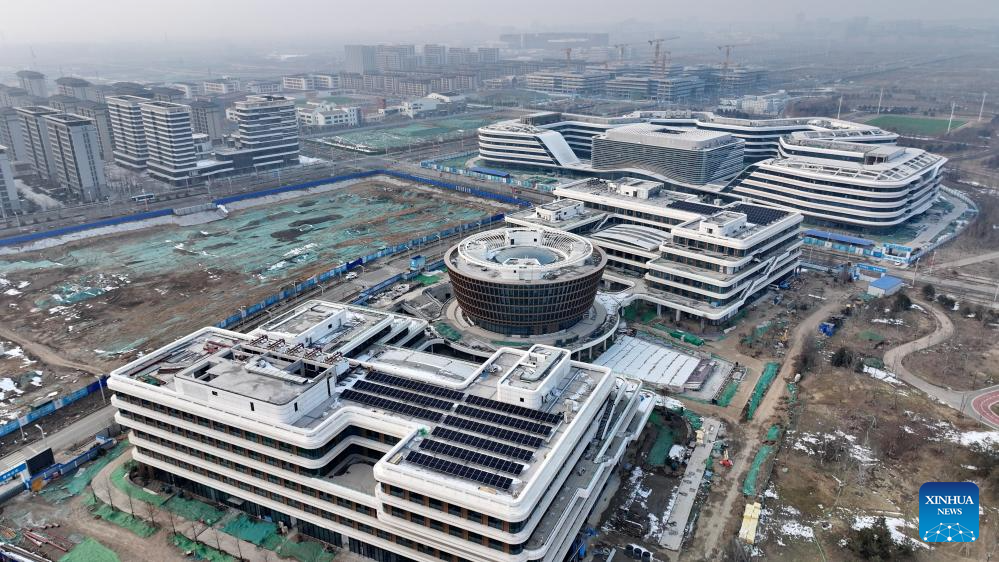
An aerial drone photo taken on Feb. 6, 2024 shows the construction site of the China Telecom smart city industrial park in Xiong’an New Area, north China’s Hebei Province.
Some 100 km away from Beijing, the Xiong’an New Area has been designed as a major recipient of functions transferred from Beijing that are not essential to its role as China’s capital.
The country has also vowed to build Xiong’an, dubbed the “city of the future,” into an innovative, green, smart and world-class city with blue skies, fresh air and clean water, in line with the country’s high-quality development path.
In less than seven years, Xiong’an has been transformed from a blueprint into reality, with over 3,000 buildings rising from the previously barren lowlands and shabby villages. Furthermore, the centrally-administered state-owned enterprises have set up more than 200 subsidiaries and various branches in the area. (Xinhua/Mu Yu)

Workers work at the construction site of an inter-city railway station and an international trade center in Xiong’an New Area, north China’s Hebei Province, Feb. 6, 2024.
Some 100 km away from Beijing, the Xiong’an New Area has been designed as a major recipient of functions transferred from Beijing that are not essential to its role as China’s capital.
The country has also vowed to build Xiong’an, dubbed the “city of the future,” into an innovative, green, smart and world-class city with blue skies, fresh air and clean water, in line with the country’s high-quality development path.
In less than seven years, Xiong’an has been transformed from a blueprint into reality, with over 3,000 buildings rising from the previously barren lowlands and shabby villages. Furthermore, the centrally-administered state-owned enterprises have set up more than 200 subsidiaries and various branches in the area. (Xinhua/Mu Yu)
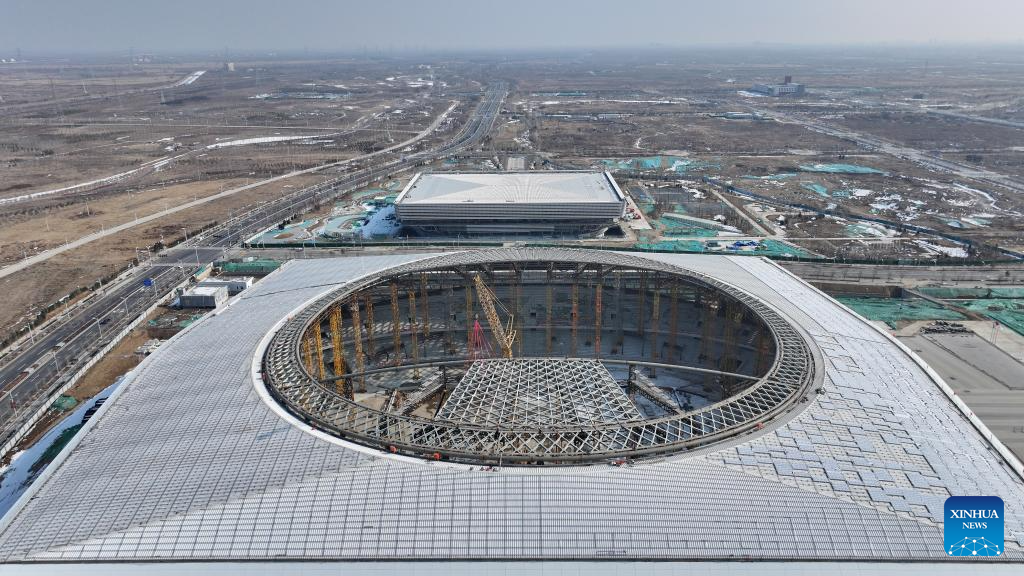
An aerial drone photo taken on Feb. 7, 2024 shows the construction site of the Xiong’an sports center in Xiong’an New Area, north China’s Hebei Province.
Some 100 km away from Beijing, the Xiong’an New Area has been designed as a major recipient of functions transferred from Beijing that are not essential to its role as China’s capital.
The country has also vowed to build Xiong’an, dubbed the “city of the future,” into an innovative, green, smart and world-class city with blue skies, fresh air and clean water, in line with the country’s high-quality development path.
In less than seven years, Xiong’an has been transformed from a blueprint into reality, with over 3,000 buildings rising from the previously barren lowlands and shabby villages. Furthermore, the centrally-administered state-owned enterprises have set up more than 200 subsidiaries and various branches in the area. (Xinhua/Mu Yu)

An aerial drone photo taken on Feb. 6, 2024 shows the construction site of the China Mobile Xiong’an smart city science and innovation center in Xiong’an New Area, north China’s Hebei Province.
Some 100 km away from Beijing, the Xiong’an New Area has been designed as a major recipient of functions transferred from Beijing that are not essential to its role as China’s capital.
The country has also vowed to build Xiong’an, dubbed the “city of the future,” into an innovative, green, smart and world-class city with blue skies, fresh air and clean water, in line with the country’s high-quality development path.
In less than seven years, Xiong’an has been transformed from a blueprint into reality, with over 3,000 buildings rising from the previously barren lowlands and shabby villages. Furthermore, the centrally-administered state-owned enterprises have set up more than 200 subsidiaries and various branches in the area. (Xinhua/Mu Yu)












